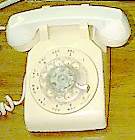

The phone, a venerable and stalwart guardian of everyday communications, is so taken for granted that we never really question just what is inside one. This deep and proprietary Western Electric Mystery is akin to the mysteries of physical plant internals, machinery found in the dark under chip fab basements and in tunnels, or really almost any other mystery as deep as that of the exact meaning of the dust and grime in the slot of a lockwasher found under the head of a particular bolt in the undercarriage of a particular item of machinery such as a bumbo pulley, locomotive, or stellerator. Such individual matter sample being in reality a fractal compressed database from which the whole machine, nay, the whole universe, could be reconstructed, if one but had the proper algorithm and point of view. But I digress... Ahem.. Back to the Phone at hand..
As you can see, the bottom of the phone bears the date. The phone comes apart by removing the two obvious screws in the bottom. Unlike the NT phone, it doesn't fall all apart into a million peices when you try to take it apart. (A VMS phone does not come apart (for most people), is adjustable from the outside, and never needs repair.)
The back of the 9C-3 dial (11/67 - a replacement?) is interesting, as it has a little plastic cover over the works. The mechanism has a small wheel which regulates the dial speed once you remove your finger from a dial hole. Inside the wheel are some centrifugal brakes. I really didn't want to try to take this apart. In the dial, there are two switches. The one on the right activates when you move the dial off the rest position, and the one on the left generates pulses when the dial is released, one for each numerical dial selected value of 1 through 0 (10).
The bell assy is interesting. Note the clapper is a crowned bushing which fits loosely on a stiff wire. The bell coil whacks this back and forth to ring the phone. This old kind of phone is where the idea of "ringer equivalency number" comes from. The number for this instrument is 1.0. The resistance between the red and red/white leads is 2713 ohms, and the resistance between the black and white leads is 997 ohms.
The hookswitch, which activates when you lift the receiver, is protected from damage and dirt by a plastic cover. The image of the hookswitch exposed was taken after the bell coil and ringer chassis was removed. The image showing the cover over the switch was taken with the chassis in place. Right in front of the hookswitch is a little rubber grommet into which the front mount of the ringer chassis fits. This mount, along with two rubber-isolated screw mounts (left rear one shown) at the rear of the ringer chassis, support the ringer chassis yet isolate its vibrations from the instrument.
One of the most interesting and mysterious parts of the fone is the Western Electric 425B network. It has a legend on the side corresponding to marked terminals on the top. The markings are cryptic, perhaps to discourage tampering. Opening the network is certainly discouraged as it is full of some kind of "goop", perhaps beeswax or grease. Whatever it was, it wouldn't melt and run off at 160 degrees F. so I gave up and left it alone. The stuff was extremely sticky and kind of nasty. I found a schematic on the internet, but it does not show hookswitch, ringer, and dial connections, only the elementary network, line, and handset connections. Nonetheless, it is very interesting. Based on the contents of the network schematic, I have drawn more of the phone's schematic around it, from examining the phone itself. Please see these interesting links:
various phone interface circuit information
http://www.hut.fi/Misc/Electronics/circuits/teleinterface.html
How phones work
http://jedi.cis.temple.edu:8080/elite/begin/phonewrk.how
more on wiring inside the phones:
http://massis.lcs.mit.edu/telecom-archives/archives/technical/wiring.inside.phones
telecom info
http://hyperarchive.lcs.mit.edu/telecom-archives/